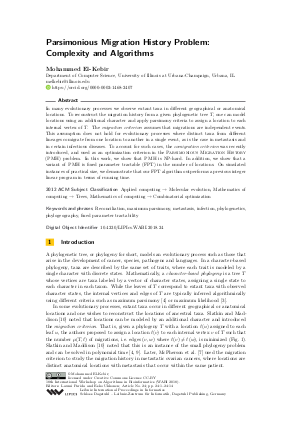Parsimonious Migration History Problem: Complexity and Algorithms
Author
Mohammed El-Kebir 
-
Part of:
Volume:
18th International Workshop on Algorithms in Bioinformatics (WABI 2018)
Part of: Series: Leibniz International Proceedings in Informatics (LIPIcs)
Part of: Conference: International Conference on Algorithms for Bioinformatics (WABI) - License:
 Creative Commons Attribution 3.0 Unported license
Creative Commons Attribution 3.0 Unported license
- Publication Date: 2018-08-02
File

PDF
LIPIcs.WABI.2018.24.pdf
- Filesize: 1.81 MB
- 14 pages
Document Identifiers
Subject Classification
ACM Subject Classification
- Applied computing → Molecular evolution
- Mathematics of computing → Trees
- Mathematics of computing → Combinatorial optimization
Keywords
- Reconciliation
- maximum parsimony
- metastasis
- infection
- phylogenetics
- phylogeography
- fixed parameter tractability
Metrics
- Access Statistics
-
Total Accesses (updated on a weekly basis)
0Document
0Metadata
Abstract
In many evolutionary processes we observe extant taxa in different geographical or anatomical locations. To reconstruct the migration history from a given phylogenetic tree T, one can model locations using an additional character and apply parsimony criteria to assign a location to each internal vertex of T. The migration criterion assumes that migrations are independent events. This assumption does not hold for evolutionary processes where distinct taxa from different lineages comigrate from one location to another in a single event, as is the case in metastasis and in certain infectious diseases. To account for such cases, the comigration criterion was recently introduced, and used as an optimization criterion in the Parsimonious Migration History (PMH) problem. In this work, we show that PMH is NP-hard. In addition, we show that a variant of PMH is fixed parameter tractable (FPT) in the number of locations. On simulated instances of practical size, we demonstrate that our FPT algorithm outperforms a previous integer linear program in terms of running time.
Cite As Get BibTex
Mohammed El-Kebir. Parsimonious Migration History Problem: Complexity and Algorithms. In 18th International Workshop on Algorithms in Bioinformatics (WABI 2018). Leibniz International Proceedings in Informatics (LIPIcs), Volume 113, pp. 24:1-24:14, Schloss Dagstuhl – Leibniz-Zentrum für Informatik (2018)
https://doi.org/10.4230/LIPIcs.WABI.2018.24
BibTex
@InProceedings{elkebir:LIPIcs.WABI.2018.24,
author = {El-Kebir, Mohammed},
title = {{Parsimonious Migration History Problem: Complexity and Algorithms}},
booktitle = {18th International Workshop on Algorithms in Bioinformatics (WABI 2018)},
pages = {24:1--24:14},
series = {Leibniz International Proceedings in Informatics (LIPIcs)},
ISBN = {978-3-95977-082-8},
ISSN = {1868-8969},
year = {2018},
volume = {113},
editor = {Parida, Laxmi and Ukkonen, Esko},
publisher = {Schloss Dagstuhl -- Leibniz-Zentrum f{\"u}r Informatik},
address = {Dagstuhl, Germany},
URL = {https://drops.dagstuhl.de/entities/document/10.4230/LIPIcs.WABI.2018.24},
URN = {urn:nbn:de:0030-drops-93263},
doi = {10.4230/LIPIcs.WABI.2018.24},
annote = {Keywords: Reconciliation, maximum parsimony, metastasis, infection, phylogenetics, phylogeography, fixed parameter tractability}
}
Author Details
References
-
A Cayley. A theorem on trees. The Quart. J. of Pure and Appl. Math., 23:376-8, 1889.

-
Mohammed El-Kebir, Gryte Satas, and Benjamin J Raphael. Inferring parsimonious migration histories for metastatic cancers. Nature Genetics, 50(5):718-726, 2018.

-
Joseph Felsenstein. Evolutionary trees from DNA sequences: A maximum likelihood approach. Journal of Molecular Evolution, 17(6):368-376, nov 1981.

-
Walter M Fitch. Toward Defining the Course of Evolution: Minimum Change for a Specific Tree Topology. Systematic Zoology, 20(4):406, 1971.

-
M Goodman et al. Fitting the gene lineage into its species lineage, a parsimony strategy illustrated by cladograms constructed from globin sequences. Systematic Biology, 28(2):132-163, 1979.

-
Richard M. Karp. Reducibility among combinatorial problems. In Complexity of Computer Computations, pages 85-103. Springer, 1972.

-
A W McPherson et al. Divergent modes of clonal spread and intraperitoneal mixing in high-grade serous ovarian cancer. Nature Genetics, may 2016.

-
H Prüfer. Neuer Beweis eines Satzes über Permutationen. Arch Math Phys, 27:742-4, 1918.

-
David Sankoff. Minimal Mutation Trees of Sequences. SIAM Journal on Applied Mathematics, 28(1):35-42, jan 1975.

-
M Slatkin and W P Maddison. A cladistic measure of gene flow inferred from the phylogenies of alleles. Genetics, 123(3):603-613, 1989.

